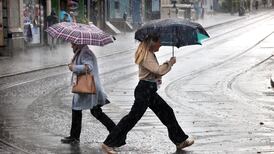Analysis:With just three months to go to polling day, an alternative coalition is still in with a chance of taking power, writes Stephen Collins, Political Editor
The election is still up for grabs. That's the message in the latest Irish TimesTNS mrbi opinion poll. The drop in support for both Government parties means that with just over three months to go to polling day, the alternative coalition of Fine Gael and Labour is still in with a reasonable chance of taking power, particularly if the Greens are included in the equation.
The two Irish Times polls taken in the wake of the Bertie Ahern payments controversy appeared to show that the Government parties were building an unassailable lead over Fine Gael and Labour, but that lead has almost vanished.
Fianna Fáil and the Progressive Democrats will be worried about the fact that their advantage has evaporated, despite a give-away budget and the publicity surrounding the €184 billion National Development Plan.
The poll is particularly worrying for the PDs with a crash in the party support to just 1 per cent. The party had been winning steady support of 3 or 4 per cent over the past three years and will be hoping that the sudden drop is an anomaly.
It is hard to reconcile with the increase in Michael McDowell's satisfaction rating or with Mary Harney's decision to take on the consultants.
For Fianna Fáil, the drop will be a disappointment. Party strategists had hoped to kill off the campaign before it even started by having a Fianna Fáil victory accepted as conventional wisdom. Still, the poll could work to the party's advantage in the long run by giving TDs and supporters a timely reminder that the election is not in the bag. The message is that they will have to work to get a third term in power.
Dublin is by far the weakest region of the country for the party and that pattern could cost it a significant number of seats on a bad day.
The Taoiseach's popularity is still a strong card for Fianna Fáil. Although his satisfaction rating is down since November, he is still well ahead of all other party leaders and that will be a formidable asset during the campaign.
For Fine Gael the one point drop will not be much of a disappointment, given the bigger reverse for both Government parties. Fine Gael has been in the 26 to 28 per cent range in the last four Irish Times polls, indicating that it has managed to push its base support to a new plateau.
It will have to gain another couple of per cent to make real inroads into its target of 30 extra seats. Fine Gael will have to fight a good election campaign to win those extra seats but will be relieved that the poll shows the prize is still attainable.
In regional terms, Fine Gael has made significant gains in Dublin over the past two years and the potential yield in extra seats is significant. It is also doing reasonably well among younger voters and is distinctively more attractive to women than men, by contrast to Fianna Fáil where the opposite applies. The one disappointing feature of the poll for the party is that Enda Kenny's satisfaction rating has slipped a bit.
As for Labour, the party vote has held solid. While Dublin is its best region its base vote is spread evenly across Leinster and Munster, giving grounds for confidence about holding its existing seats.
However, it is not as strong in Dublin as it was in previous polls and that could make gains difficult to achieve. It is also weakest among younger voters which could have long-term consequences.
A positive for the party is that Pat Rabbitte appears to have established himself as the second most popular party leader in the Dáil, after the Taoiseach, and that should be a real asset during the campaign. His high profile on the coalition issue in the weeks before the poll appears to have reinforced his standing.
The Greens have probably more to cheer about than any other party. Their level of support has doubled from 4 to 8 per cent since the last Irish Times poll. Equally significant is that the party has edged ahead of Labour as third biggest party in Dublin.
That indicates that it should comfortably hold on to its existing five seats in the capital and be in with a good chance of gaining another few.
Outside Dublin, though, the party is very weak and its support is heavily concentrated among younger voters.
The party gets twice as much support among women as it does among men and it does much better among middle-class voters than among working-class voters or farmers.
The improvement in the level of support for Sinn Féin will be a boost to the party as it had been dropping in recent polls.
There was clearly a positive impact from last weekend's ardfheis on policing and the attendant publicity for leading party figures. One disappointing feature of the poll for the party is that its vote in Dublin is well below that achieved in the capital two years ago. Its strongest region is Connacht- Ulster where it has targeted seat gains in the election.
In terms of gender and social class Sinn Féin is the reverse image of the Greens. Its support among men is more than double that among women and it is much stronger among working-class voters than middle class ones.
The level of support for Independents and Others at 8 per cent remains solid which indicates that most of the Independent TDs and those from smaller parties should make it back to the Dáil, while there could be a few new surprise faces from this group.







